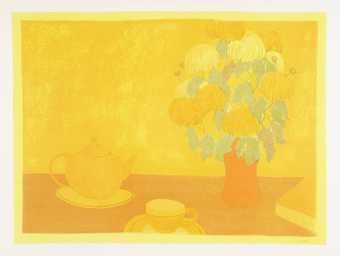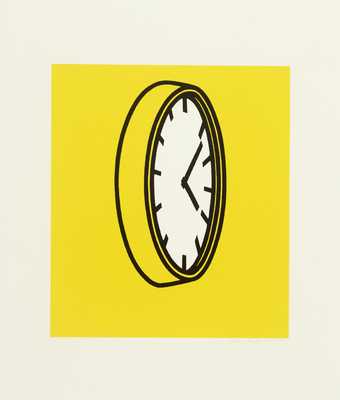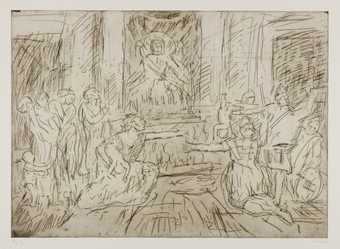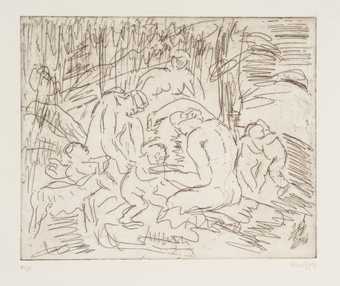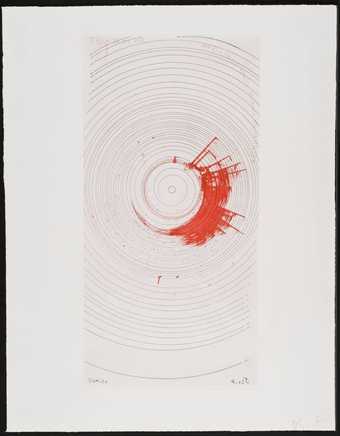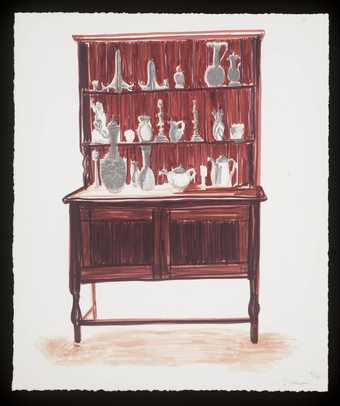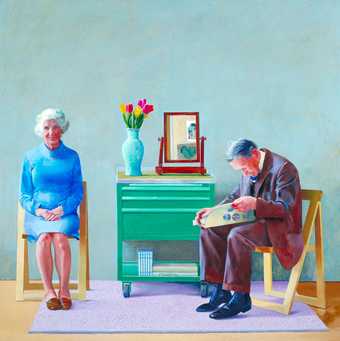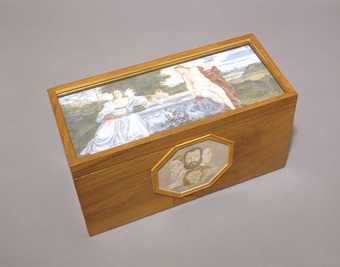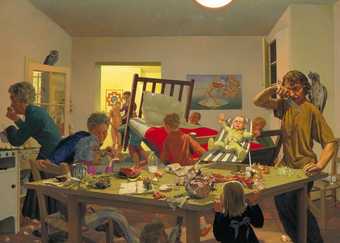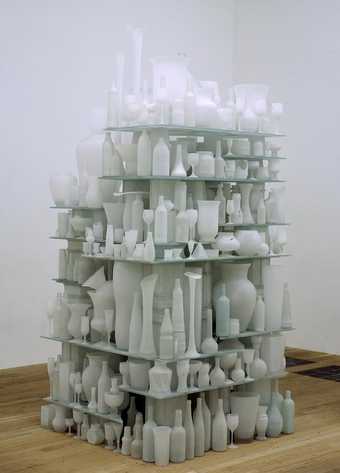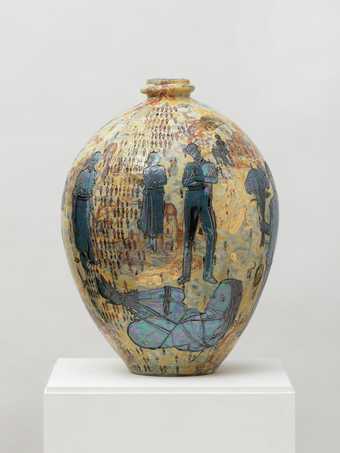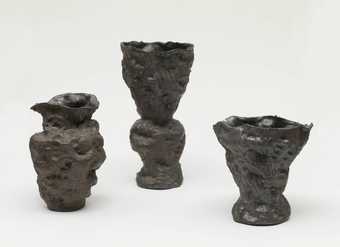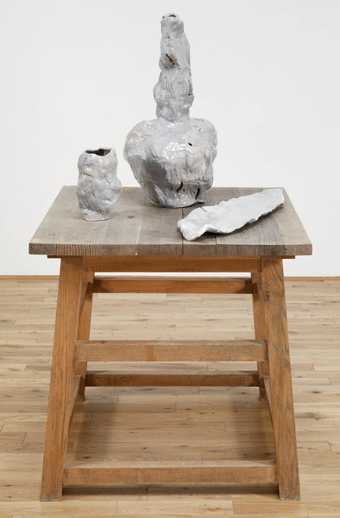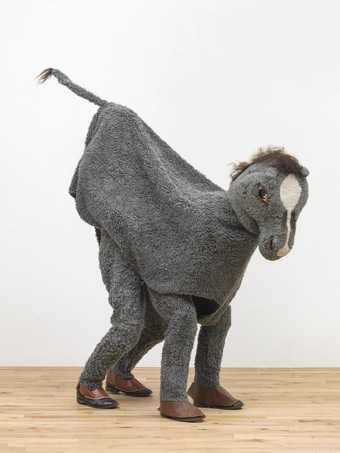Not on display
- Artist
- Sir Grayson Perry CBE RA born 1960
- Medium
- Earthenware
- Dimensions
- Object: 400 × 345 × 330 mm, 9 kg
- Collection
- Tate
- Acquisition
- Purchased with assistance from Rob Taylor and Michael Kallenbach 2002
- Reference
- T07940
Summary
My Gods 1994 is a ceramic vase by the British artist Grayson Perry that depicts four large figures, each presented in their own white vignette set within the green glaze of the vase’s surface. These characters each represent one of the four ‘Gods’ referred to in the title. One of them is labelled ‘Doreen, the god of cleanliness and vengeance’, who strangles a small, pale-skinned boy wearing a t-shirt that reads ‘childhood ends in divorce’, reaching out her serpent’s tongue towards him while holding a spray can labelled ‘anal: things have to be clean’. The second female god is unnamed, but takes the form of a dominatrix with hair fanned outward, resembling the head of Medusa. Blood falls from her lips, and there are wounds and drips of blood on the face of a small male companion whom she holds. The man on the motorcycle, whose penis penetrates the machine he rides, is labelled Luigi, the ‘god of quiet machismo’. The fourth of Perry’s gods, ‘Alan, the god of imagination’, provides a retreat from the violence of the others depicted: here, a contented child sits reading upon the deity’s knee. This god’s clothes are printed with images of nature and behind him is a pleasant-looking house in a country landscape. Decorative patterns cover the green-glazed surface between the four vignettes featuring the gods. On one side a corkscrew floats between a black knotted symbol and the words ‘My Gods’ that are carved into the vase’s face. A three-dimensional hand reaches out towards the viewer, a face moulded into each of its fingertips, and further along the vase protrudes a creature with a man’s body and the head of a teddy bear, wearing a bra and spreading his body outwards in a shape reminiscent of a crucified Christ. Symbols litter the work’s surface, including Chinese-style motifs and a band of tiny Nazi swastikas around the vase’s base. My Gods is only slightly larger than a standard domestic vase and as such the viewer must stand close to the work in order to see the detailed imagery that it displays.
Perry made My Gods in his London studio in 1994. He began by applying a base white slip to the vase, onto which he stencilled the four main scenes featuring the ‘gods’. He followed this with layers of cream and grey slip to which he applied smaller stencils, transfers and the background pattern. Finally, Perry added the copper oxide slip that produced the green effect, and drew the outlines of the figures and vignettes onto the vase with a potter’s knife before biscuit-firing the work at 1020C. He then rubbed black slip into the incisions he had made, applied a glaze and fired the piece at the slightly higher temperature of 1080C. Finally, Perry covered the relief elements of the pot with a bronze glaze, applied transfers on top of the glaze and fired the vase again at a lower temperature of 760C. It is the repeated layering and firing process that gives the work its illusion of depth and allowed Perry to incorporate a great level of detail into the pot’s surface.
The title of the work suggests that each figure on the vase symbolises a different deity that is part of Perry’s personal theology. The artist stated in 2009 that while making this work he ‘was looking back and inventing my own gods’, and that these were intrinsically connected to his conception of his parents because
an innocent child worships gods that have aspects of its parents in them: there’s a sort of projection of parent onto god. Some people have a very screwed up idea of god: if you have a vengeful parent you probably have a vengeful god.
(Quoted in Klein 2009, p.176.)
Perry’s parental ‘gods’ and their settings are not conventionally nurturing and appear abusive, and as such the figures and symbols in My Gods may be associated with the artist’s tumultuous relationship with his own parents, which he has written about extensively. For instance, Perry has stated that the corkscrew symbolises ‘the image of a crucifix and also the hint at parent alcoholism’, and its position on the vase, hovering above the inscribed title, suggests further the connection between the four gods and the artist’s negative familial experiences (quoted in Klein 2009, p.176).
My Gods is one of many vases Perry has made throughout his career that the artist has termed ‘stealth bombs’, referring to the way in which they combine the traditional ceramic medium with explicit scenes (quoted in Klein 2009, p.225). According to Klein, it is this that gives the works their ‘radical edge … If his forms are the very epitome of the middle-class drawing-room aesthetic, his spiky and explicit content undermines that, repeatedly and intentionally wrongfooting the viewer’ (Klein 2009, p.225). In this way, Perry’s ceramic work also challenges the divide between fine art and craft, and although he is of the same generation as the Young British Artists, who are mainly known for producing conceptual sculpture, installation and video art, Perry has described himself as ‘a conceptual artist masquerading as a craftsman’ (quoted in Klein 2009, p.225).
Further reading
Wendy Jones and Grayson Perry, Grayson Perry: Portrait of the Artist as a Young Girl, London 2006.
Jacky Klein, Grayson Perry, London 2009, p.176.
Grayson Perry, Grayson Perry: The Tomb of the Unknown Craftsman, London 2011.
Michal Goldschmidt
October 2014
Supported by Christie’s.
Does this text contain inaccurate information or language that you feel we should improve or change? We would like to hear from you.
You might like
-
Bernard Myers Chrysanthemums
1978 -
Patrick Caulfield 7. ‘Crying to the walls: My God! My God! Will she relent?’
1973 -
Leon Kossoff Judgement of Solomon (2)
1998 -
Leon Kossoff The Nurture of Bacchus
1998 -
Damien Hirst Oh my God ... and for those really stubborn stains!!!!!??*
2002 -
Jane Simpson Swiss Cottage
2008 -
David Hockney My Parents
1977 -
John Lessore Allegorical Box
1976 -
Jonathan Leaman A Jan Steen Kitchen
1995–6 -
Tony Cragg Cumulus
1998 -
Mark Wallinger Hymn
1997 -
Sir Grayson Perry CBE RA Aspects of Myself
2001 -
Andrew Lord Three Vases. Fist
1985–6 -
Andrew Lord breathing
1996–2000 -
Mark Wallinger Behind You!
1993


